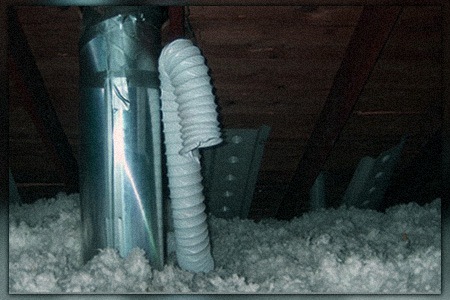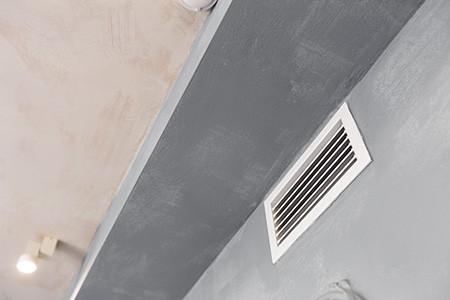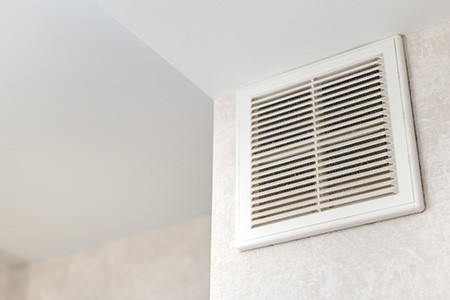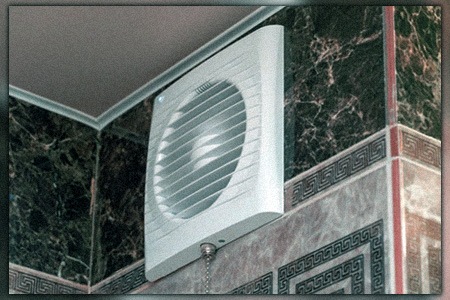Can a Bathroom Fan Vent Into an Attic? No & Why
Author: Omar Alonso | Editor: Omar Alonso
Review & Research: Jen Worst & Chris Miller

Walking into a hot, humid bathroom after someone's taken a shower or bath isn't a comfy sensation. The air feels clammy, and moisture clings to your skin. Wouldn't it be great if you could resolve this problem? Can a bathroom fan vent into an attic?
The only issue with installing a bathroom fan is that you have to vent the air somewhere, and the most popular choice with homeowners who don't know better is to push it into the attic. Is it a good idea to set up a bathroom fan vent into attic spaces? Or should you look for other options?
Let's examine the issue and look at some alternative venting options, since (spoiler alert!) you can't vent your bathroom into the attic.
Can You Vent a Bathroom Fan Into an Attic?

Sure, you could vent the bathroom fan into the attic, but it's not a good idea. You risk damaging your home if you choose this option. Did you know venting moisture into the attic from the bathroom is actually a code violation? Why?
Moisture attracts mildew and mold, creating a health hazard in your home. These airborne spores can spread throughout the rooms, causing respiratory problems and flaring allergies. The attic isn't a temperature-controlled space, and when warm moisture coming from a vent mixes with cool air, it condensates.
Condensation will drip from the attic rafters, creating water stains that damage ceiling boards. If you vent bathroom air into the attic, you'll end up with a moldy attic and home and the need for a costly ceiling repair. People ask the same about venting a dryer into their garage. Nope, don't do it, for the same reasons.
Bathroom Fan Venting Options
Plenty of other options for venting bathroom air don't involve pushing it into the attic. Let's discuss some alternatives that meet United States building codes. However, before implementing any of these strategies, check with your local municipality to ensure it meets the code requirements.
Roof Vents

Send the moisture to the roof and outside of the home through any types of roof vents. You'll need to set up ducting, which is more costly and time-consuming than other options, but you exhaust the air safely with no chance of mold infestation.
If you go this route, you'll need to insulate the ducting to prevent condensation inside the lining. The ducting penetrates the roofing system to its exterior, and a hood covers the exhaust point, ensuring rain and snow don't enter.
However, you'll need a proper hood to ensure insects and birds do build nests inside it. Ensure you have the right size vent grates to stop this from occurring. Since this is an extensive job, it's unsuitable for a DIY installation unless you have extensive handy experience.
Through-Wall Vents
This option is the most popular for bathroom fan vents. We're talking about an exterior wall, not a bathroom fan vent into an attic through a ceiling wall. The installation professional has more options for routing the ductwork, allowing for a custom, easy installation that takes the shortest route to the home's exterior.
A through-wall installation runs from the ceiling or the wall through to an exterior wall, venting the moisture outdoors. Most installations go from the ceiling directly to an outer wall, providing the shortest route possible and a minimalist ducting setup that doesn't require insulation like the roof vent option.
However, suppose your bathroom has other rooms between it and the exterior wall. In that case, a professional can run the ducting through the ceiling or wall, customizing the installation to take any path. Through-wall vents require a vent cover with flappers that open when the air pressure from the fan moves through the ducting.
The flappers close when the fan turns off, and the pressure in the ducting drops. This design prevents insects and birds from entering the ducting. You'll need to ensure proper sealing of the vent to avoid leaking and causing water damage or mold growth in the walls.
Soffit Vents
The soffit vent is another option if the first two won't work in your home. It's not the best choice; many cities, as well as the IRC, see this vent type as a building code violation. So, check with your local municipality before approving the installation.
It's an uncommon venting style, and it can cause issues with water damage. Soffit vents are small and discreet and less visible from inside the bathroom. They're barely visible from the home's exterior unless you look underneath the roof overhang.
It's usually the most affordable option of the three venting designs mentioned in this post. However, it depends on your home's layout. While the soffit vent removes moisture and keeps insects and birds from nesting, it disrupts the airflow, creating the potential for moisture damage to the roof rafters.
If you're considering this option, remember to check local building codes in your area. We also advise hiring a professional for the installation.
Bathroom Wall Fans

Fitting a low-profile wall fan is a good choice for homeowners that don't already have a ceiling fan in place. It's also an option for bathrooms that can't vent to the roof or an exterior wall through a ceiling duct.
Wall-mounted fans usually come with a sleek, low-profile design that fits seamlessly between the wall studs. The vent goes directly through the wall to the home's exterior, similar to the through-wall design we mentioned earlier.
The direct flow path reduces the need for a larger vent, allowing for a smaller fan that doesn't look intrusive. It's usually a straightforward installation. However, unless you have the tools and DIY skills to drill through the wall and wire up the fan, you'll need the assistance of a professional for the job.
The exterior vent usually features the flapper setup we discussed for the through-wall installation so there's no back flow of outside air into the home. As you can imagine, even a bathroom fan vent into an attic would need this, if you could exhaust the air there (you can't).
Costs to Install a Bathroom Fan Exhaust Vent
The cost of fitting a bathroom fan depends on factors like the vent option you choose, whether you need the help of a professional installation service and the amount of ducting and effort required to complete the installation.
The price of the fan is far less than the ducting and hood or cover, but the installation is where you'll have to spend the most if you choose to hire a professional for the job. Exhaust fans cost anywhere from $30 to $70, depending on their size, features, and manufacturing brand.
It's usually a good idea to spend a little more on the fan, and we recommend going with a model that features a quiet "Tech Drive" system for minimal noise during operation. The roof vent kit will set you back $25 to $60 for models that feature a built-in pest guard and damper.
Roof vents usually also require a few shingles and flashing to ensure a watertight fit. Through-wall vent models typically come in more style options, with colored plastic housings or stainless steel finishes available.
It's hard to estimate the final cost of the installation since most installations are customized for the home. However, full kits are available for any fitment, including varying lengths of ducting for the job.
The average DIY job costs around $100 (if you have the tools and skills already) or up to $300+ for a professional installation. The project costs can get expensive if a professional has to run the ducting through several walls or onto the roof. Adding to the costs of flashing and waterproofing to this job could end up pushing the installation costs up to $500 or more.
The average handyman service could charge you $100 to run a vent through a wall in a direct fan installation. The fan's location in the bathroom, the ducting length, and the extent of the job are the biggest factors involved with final project costs.
We recommend shopping around. Get quotes from two or three professional installation services, and always ensure they offer a guarantee on their work. If any of them suggest the bathroom fan vent into the attic, you know that they aren't working by code and you should reject them.
Bathroom Exhaust Fan FAQ’s

Here’s a few other questions that tend to arise when we start discussing venting a bathroom fan into an attic. There’s a lot that’s involved, so naturally we need to start digging into the details.
Can I Vent a Bathroom Fan Into a Gable Wall?
Yes, this type of installation is possible, but you run the risk of violating building codes and the problems involved with leaks and damage. Typically, you'll need a professional installation to ensure proper fitment and waterproofing to avoid these issues.
Can I Install a Bathroom Exhaust Fan Vent Myself?
If you have DIY skills and the right tools for the job, installing a bathroom fan is relatively easy. However, you'll need to wire the fan to your home's electrical system, so consider that when planning the job. This is also assuming any ducting is already in place to carry the vented humidity out of the home.
Can I Use a Plumbing Vent to Exhaust a Bathroom Fan?
No. This installation violates the IRC’s building code M1501.1 and is just as bad, if not worse, than venting the fan into the attic. This code states: “The air removed by every mechanical exhaust system shall be discharged to the outdoors in accordance with Section M1504.3. Air shall not be exhausted into an attic, soffit, ridge vent, or crawl space.”
Key Takeaways for Venting a Bathroom Fan Into an Attic

Let’s recap the main points we’ve learned from above to reinforce it deep into our minds:
- Don't vent the bathroom fan into the attic. It violates building codes, creates a health hazard, and damages the building structure.
- Vent through the wall or the roof directly to the outside for the best results.
- Bathroom fan vent installations can range between $100 to $500, depending on the amount of work involved and whether you choose a DIY or professional installation.
- Get several quotes if you're using a professional for the job, and ensure they guarantee the work.
- Don't vent the fan using a plumbing vent such as a toilet venting pipe.
It sounds pretty simple when you say it like that, and it is for a professional. The challenge for a DIY job is establishing the actual venting ducts or pipes if they aren’t already in place. This can be quite the task that brings in a lot of other variables you may not have experience with, like cutting and patching drywall.
So, Can a Bathroom Fan Vent Into an Attic?
No, you cannot, if you wish to abide by IRC building codes and refrain from introducing humidity into your attic which could become a breeding ground for mold. Even if the temptation is great, just accept that it’s not an option. You must convey the moisture directly to the outdoors, period. A bathroom fan vent into an attic is simply off limits.



